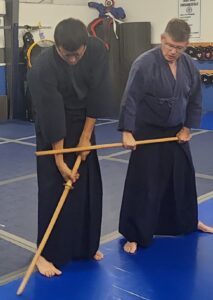Our curriculum is structured around the traditional forms (kata) of Shintō Musō-ryū. Students begin with kihon (fundamentals) and progress through paired kata using the jo against the sword. Each level develops timing, distance, control, and focus.


Train with Precision. Honor the Tradition
Jodo is a 400-year-old Japanese martial art. It was founded by Muso Gonnoske about 1640 in response to a duel. Since that time, it has been handed down from teacher to student continuously for generations. A comprehensive overview of Jodo can be found here.
The curriculum can be summarized as follows
-
- 12 basic movements called kihon
-
- 64 techniques broken down into sections called Omote, Chudan, Kage, Sami Dare, Go hon no Midare, and Oku.
-
- More details can be found here.
Students learn both the jo and sword side of techniques. So Jodo is also a sword school. It is all kata, or prearranged forms. There is no sparing, making it suitable for all ages, including both men and women.
There are “attached” weapons, such as the sickle and chain (kusari gama), short staff (tanjo), and short metal truncheon (jutte), as well as knot-tying techniques. However, these are only taught after the jo and sword curriculum and are not the focus of the art.
“To learn Kata (型) is to identify yourself with it and eventually come to understand Kata (形). Kata (形) is formless because it is a spirit, so it has infinite variety.”
— Nishioka Tsuneo, The Lore of the Jo (1989) Tweet

Benefits of Studying Jodo
- Connection to Tradition Each movement links to centuries of martial history, passed through a living lineage with care and integrity.
- Respect and Etiquette The art reinforces humility, gratitude, and disciplined behavior inside and outside the dojo.
- Personal Growth By confronting one’s limitations, Jōdō becomes a path of transformation, not just a technique.
- Physical Control Training develops coordination, posture, and refined body mechanics without relying on brute strength.
- Timing and Distance Students learn to read subtle cues and respond with exact timing and maai (distance), essential in classical combat.
- Weapon Proficiency Jōdō offers a deep understanding of traditional weapons, especially the short staff (jō) and its dynamic interaction with the sword.
- Situational Awareness Through kata, practitioners sharpen their ability to perceive openings, anticipate movement, and act with purpose.
Frequently Asked Questions
How much do classes cost?
Class fees are usually low to make the art more accessible to everyone. Some teachers teach through the local parks and recreation, which are affordable to most.
What equipment is required and what is the cost?
Only a 50-inch stick is needed to start. Some teachers provide one for use during the class. If this art is right for you, we recommend that you purchase a jo and a wooden sword. After training for a while, if you realize this is something you want to invest time and money in, you can purchase a uniform. Compared to most martial arts, the costs are low.
Are there ranks in this system?
No, there are no ranks like in modern martial arts. There are no tests. Certificates are awarded, but they are not the primary focus of this art and are at the instructor’s sole discretion. We train and learn more as we go along.
Are there classes for children?
No, not at this time. The minimum age is 16 years old.
How strenuous is it? Is it suitable for all ages?
We practice the basic movements and techniques at a steady and reasonable pace. Most people will find it doable. The focus of the class is not physical conditioning but rather to learn techniques.
What do I wear?
If you are not wearing a uniform, we ask that you wear loose and comfortable clothing suitable for exercise. Out of respect for the art and those around you, your clothes should be clean and in good repair.